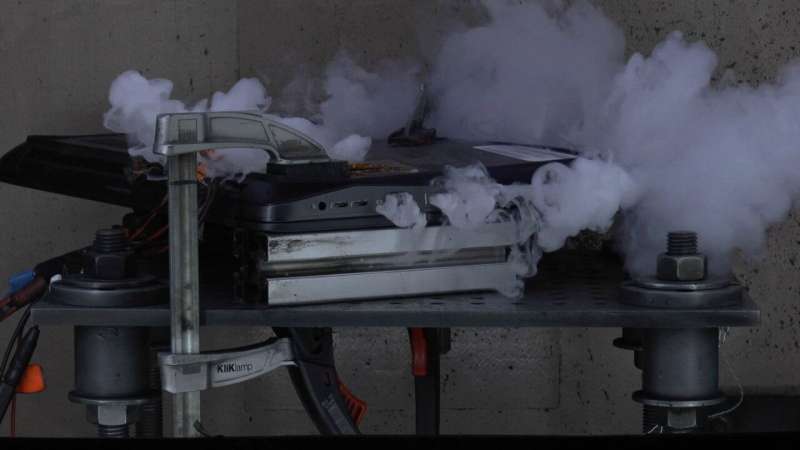This article has been reviewed according to Science X's editorial process and policies. Editors have highlighted the following attributes while ensuring the content's credibility:
fact-checked
trusted source
proofread
Using laptops and similar devices safely on aircraft

The number of incidents involving damaged electronic devices on board aircraft has increased in recent years. Most of these are caused by lithium-ion batteries, which are found in laptops and other portable electronic devices.
In the LOKI-PED project, the Fraunhofer Institute for High-Speed Dynamics, Ernst-Mach-Institut, EMI and the Fraunhofer Institute for Building Physics IBP are collaborating with Airbus to assess the fire and smoke risks associated with lithium-ion batteries in cockpits and cabins. The objective is to make it safer to use portable devices on board.
Nowadays, living without portable electronic devices (PEDs) is inconceivable. Smartphones, laptops, tablets, digital cameras, e-book readers and smartwatches are our constant companions—on plane journeys just as much as anywhere else. Passengers, however, are not always aware of the risks: If a PED gets caught in a seat or overheats while charging, the lithium-ion battery inside it can heat up and expand. In extreme cases, it can give off hot, toxic and flammable gases that could put passengers and crew members at risk.
According to the Federal Aviation Administration (FAA), incidents caused by lithium-ion batteries on passenger flights have increased in recent years. The administration estimates between 35 and 50 cases per year. On December 26, 2022, a Lufthansa aircraft even had to make an unscheduled landing at O'Hare International Airport in Chicago after an overheated laptop belonging to a passenger started a smoldering fire in the cabin.
This alarmingly high rate of incidents can be attributed to the growing number of PEDs and lithium batteries being brought on board, including e-cigarettes, power banks and battery-powered screwdrivers. In the LOKI-PED (Lithium batteries in pOrtable electronic devices—risK of fIre and smoke) project, researchers at Fraunhofer EMI and Fraunhofer IBP are collaborating with Airbus to investigate and assess the smoke and fire risks associated with lithium batteries in PEDs in cabins and cockpits. The project is supported by the European Union Aviation Safety Agency (EASA) and financed by the European Union's Horizon Europe program.
Test bench and flight lab tests
"A scientifically sound risk assessment is urgently needed, especially as cabin and firefighting procedures have not changed since 2014. In LOKI-PED, we are investigating whether standards need to be updated and new guidelines and protective measures established to minimize risks," says the project manager Dr. Simon Holz of Fraunhofer EMI. Dr. Holz's team is complemented by Dr. Victor Norrefeldt, technical manager at Fraunhofer IBP, and his research group, alongside experts from Airbus.
The project partners are working on characterizing the main risks of PEDs and the effects of fire and smoke in cockpits and cabins, assessing the risks in view of the number and energy content of PEDs, evaluating emergency measures and additional countermeasures—such as ventilation and protective bags—and identifying gaps in the regulatory provisions.
The consequences of smoke and fire are being investigated at high-performance test benches such as the Flight Test Facility at Fraunhofer IBP and the TEVLIB battery testing center at Fraunhofer EMI. The TEVLIB center offers unique conditions for carrying out destructive tests, even on large battery systems, while maintaining the highest standards of safety. The experiments serve as a basis for numeric simulations and the subsequent risk assessment.
A short circuit in the battery cell
The first step for the researchers at the Fraunhofer EMI TEVLIB battery testing center was to carry out battery abuse tests in which the batteries in laptops, tablets, smartphones and battery-powered screwdrivers were heated up in order to trigger thermal runaway. This is a process in which the lithium-ion battery burns away, releasing all the chemical energy from the cell in a very short time. An internal short circuit in the battery cell produces a very high electrical current, which causes a sharp rise in temperature. Once the onset temperature is reached, the thermal runaway in the battery cell can no longer be controlled.
"Lithium batteries in PEDs contain different types and numbers of cells. The high temperature sets off a chain reaction, where the heat produced in one cell triggers thermal runaway in the cell next to it as well," the engineer explains. "The amount of gas released is proportional to the amount of energy in the battery."
The researchers have not yet completed their characterization of the gases released. The next planned step is to conduct experiments in realistic aircraft environments with the appropriate cabin ventilation in an A320 mockup and at the Flight Test Facility at Fraunhofer IBP.
Energy content determines the amount of heat and gas released
"If a PED does overheat, the amount of heat and gas released is determined by the energy content of the batteries. PEDs that can be brought on board are currently limited to 100 watt-hours (Wh). Laptop batteries must not have a capacity of more than 100 Wh. In the future, devices with increasingly high energy densities will be brought onto the market," says Holz in clarification of the difficulties faced.
"Our tests are investigating whether the 100 Wh limit is enough, so that regulations can be adapted, and new protective measures can be installed if necessary. Once the tests have been completed, airlines, regulatory authorities, cabin crew and passengers will all benefit equally from our scientific proposals, in terms of ventilation system designs and certifications for suitable safety equipment, for example."
The project team is in close contact with members of the aviation industry; one exchange on thermal runaway in batteries in cabins and cockpits took place in a panel discussion at the IATA World Safety & Operations Conference 2023.





















